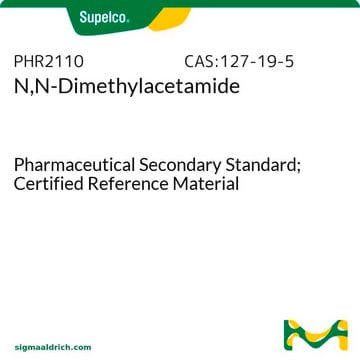154806
N,N-diméthylacétamide
spectrophotometric grade, ≥99%
About This Item
Produits recommandés
Qualité
spectrophotometric grade
Densité de vapeur
3 (vs air)
Pression de vapeur
2 mmHg ( 25 °C)
4 mmHg ( 38 °C)
Pureté
≥99%
Forme
liquid
Température d'inflammation spontanée
914 °F
Limite d'explosivité
1.8 %, 100 °F
11.5 %, 160 °F
Technique(s)
UV/Vis spectroscopy: suitable
Impuretés
<0.050% water
Résidus d'évap.
<0.001%
Indice de réfraction
n20/D 1.437 (lit.)
pH
4 (20 °C, 200 g/L)
Point d'ébullition
164.5-166 °C (lit.)
Pf
−20 °C (lit.)
Densité
0.937 g/mL at 25 °C (lit.)
λ
H2O reference
Absorption UV
λ: 270 nm Amax: 1.00
λ: 280 nm Amax: 0.30
λ: 290 nm Amax: 0.15
λ: 310 nm Amax: 0.05
λ: 320 nm Amax: 0.03
λ: 360-400 nm Amax: 0.01
Chaîne SMILES
CN(C)C(C)=O
InChI
1S/C4H9NO/c1-4(6)5(2)3/h1-3H3
Clé InChI
FXHOOIRPVKKKFG-UHFFFAOYSA-N
Vous recherchez des produits similaires ? Visite Guide de comparaison des produits
Description générale
Application
Mention d'avertissement
Danger
Mentions de danger
Classification des risques
Acute Tox. 4 Dermal - Acute Tox. 4 Inhalation - Eye Irrit. 2 - Repr. 1B
Code de la classe de stockage
6.1C - Combustible acute toxic Cat.3 / toxic compounds or compounds which causing chronic effects
Classe de danger pour l'eau (WGK)
WGK 2
Point d'éclair (°F)
147.2 °F - closed cup
Point d'éclair (°C)
64 °C - closed cup
Certificats d'analyse (COA)
Recherchez un Certificats d'analyse (COA) en saisissant le numéro de lot du produit. Les numéros de lot figurent sur l'étiquette du produit après les mots "Lot" ou "Batch".
Déjà en possession de ce produit ?
Retrouvez la documentation relative aux produits que vous avez récemment achetés dans la Bibliothèque de documents.
Les clients ont également consulté
Notre équipe de scientifiques dispose d'une expérience dans tous les secteurs de la recherche, notamment en sciences de la vie, science des matériaux, synthèse chimique, chromatographie, analyse et dans de nombreux autres domaines..
Contacter notre Service technique






